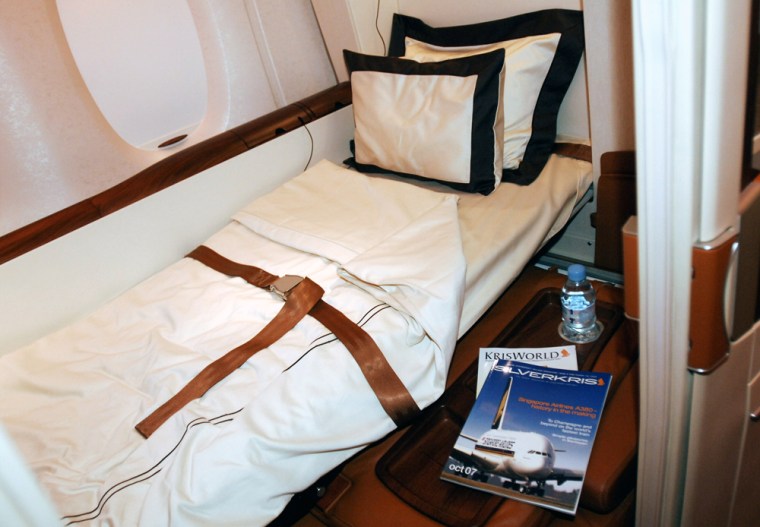In some ways, Andy Abramson's morning routine is typical: He shaves, brushes his teeth and combs his hair before slipping on some nice slacks and a shirt for a meeting with a client.
But what's not typical about Abramson's routine is that he isn't doing any of this in his Del Mar, Calif. home. He's preparing for a day of meetings aboard one of several commercial airlines that promises to provide all the comforts of home, including a good night's sleep.
Call it the evolution of first class, or a return to the days when flying was glamorous, but an increasing number of airlines are offering flat-bed seats to business and/or first class international passengers.
Unlike lie-flat seats, which are angled, flat-bed seats recline to a full 180 degrees. The bed dimensions vary depending on the airline: Virgin Atlantic's seat length is 79.5 inches; British Airways is 72 inches in business class and 78 inches in first class.
"I'm 6-foot-tall, and I feel comfortable in it," said Abramson, who is CEO of an international marketing company. "I'm able to sleep flat out without having to curl my toes or bend my knees. Whenever I take a West Coast London flight, I usually spend half to two-thirds of the flight asleep, more than I get at home. It sure makes it easier if you have to get off the plane and you want to be functional."
Of course, a bed on an airplane is not a new idea. In the 1930s, Pan Am's Clippers, which took off from the water, had berths that folded down into beds. Post-World War II, the airline's Boeing 377 Stratocruisers offered sleeper seats. In the '80s, Japan Airlines and Philippine Airlines had spiral staircases leading to an upper deck of curtained off beds aboard their 747s. Eventually the beds were eliminated.
But because of deregulation and increased competition, the economics of the airline industry changed, said Dan Petree, dean of the College of Business at Embry-Riddle Aeronautical University. It became much more difficult to allocate spending space on beds over seats, he said.
"I think now we're seeing attempts by airlines to differentiate their brands, to try to create additional value in terms of the service they provide their customers," he said. "I think that's one of the reasons we are seeing this tendency to pay attention to the relatively high-margin business flier."
British Airways was the first in 1996 to put in flat-bed seats for first class passengers, and in 2000 for British Airways' business class, called Club World. Other airlines followed, including South African Airways, Virgin Atlantic, Air Canada, Cathay Pacific and Singapore Airlines. (Several other airlines have the angled lie-flat seats).
U.S. carriers, set back because of financial troubles, are trying to catch up.
United Airlines became the first U.S. carrier last month to offer flat-bed seats in international business cabins. Delta is planning to begin introducing flat-bed seats in business class starting next year. And American is continuing to replace some of its business-class seats with angled lie-flat seats.
"The challenge for the airline is that when you are completely flat, you are taking up more space on the plane and can't fit as many of these on the plane," said Matt Daimler, founder of SeatGuru.com. "Lie-flat (angled) seats allow them to get a good number of seats on the plane and still offer more comfort."
The perks of airborne beds go beyond peaceful sleep. Singapore Airlines' new Airbus A380 has suites with double beds, sliding doors, wardrobes and window blinds. Virgin Atlantic offers its Upper Class, or business class, passengers ground transportation, in-flight massages, and a clubhouse at the airport where they can shower, dine and check email.
"The private suites we seeing from airlines like Singapore are essentially condos in the clouds," said Robert Buckman, director of airline distribution strategies for Amadeus North America. "The sleeping arrangements and other amenities go well beyond the lie-flat seating option, but so does the price. These private suites are designed to attract a certain type of luxury or very VIP traveler looking for a very exclusive travel experience."
Fueling the demand for lie-flat beds is competition between the airlines for premium passengers, more valuable to an airline than coach passengers. First class/business class international tickets can cost thousands of dollars more.
Over the years, sitting up front became a place for a person with lots of miles who wanted more leg room and free alcohol, said George Hoffer, economics professor at Virginia Commonwealth University. So it became hard for passengers and companies to spend thousands of dollars without feeling like they were getting a lot more for their money.
"I liken the sleeper compartments to in essence trying to recreate what used to be called Pullman class service, ultra-first class service," he said. "'Give them more space and hopefully charge them a premium price such that it more than covers the extra space we have given them.'"
A good night's sleep on an overnight flight can make the difference in how well business executives function the next day, said Buckman. But he said vacationers are taking advantage of the beds as well. While there is no hanky-panky allowed, even with double-bed suites, "that honeymoon to Hong Kong is definitely more enjoyable and less stressful — for the happy couple if they can get there and back a little easier and more comfortably," Buckman said.
For coach passengers who may complain of fitful sleep, German airline Lufthansa is considering an all sleeper-seat economy cabin with triple bunk beds.
Abramson said airplane beds have made his life much easier.
"You don't have to worry about the person next to you chatting your ear off," he said. "You don't have to worry about being crushed in the seat. It's not a hotel bed, but considering where you are and what you are doing, it's a very comfortable way to fly if you can afford to fly that way."
